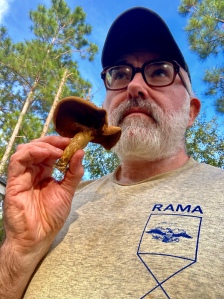
I found this mushroom in my backyard. It had several holes in it that looked like it had been invaded by worms or insects. It was discolored and appeared to look like it was rotting.
When I ran the picture of it through a plant identifier app, the result was the ash tree bolete.
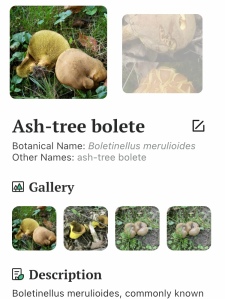
While the app says it is an ash tree bolete, it may be another type of bolete. There are many types of bolete mushrooms. The app picked the ash tree version so that’s the closest match that I could find so I’m rolling with it.
Some of the key identifying features of this mushroom are the spongy like surface under the cap, it has no gills, and it has a pinched, wavy portion towards the rear of the cap.
There are some sites which say this mushroom is edible while others say it is not. Even the sources who say it is edible, say that it doesn’t taste good.
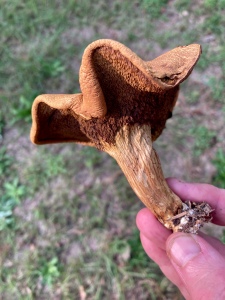
Fungus Fact Friday says the following: B. merulioides gets mixed reviews when it comes to edibility. Some websites list it as edible while others say inedible.
Within the edible group, the consensus seems to be that the mushroom is not particularly good (although it might be better when very young). In eastern North America, the general rule for boletes is: don’t eat it if it has red pores, stains blue, or is too bitter.

Unlike nearly every other bolete, the Ash Tree Bolete has a stipe that is rarely in the center of the cap. More often than not, the stipe is off-center (eccentric) and is sometimes found at the edge of the pileus (lateral). The stipe is only 2-4cm tall while the cap grows 3-20cm, making the mushroom rather short and stocky.
Below the end of the tube surface, the stipe is dark brown or the same color as the cap. All surfaces bruise brownish or sometimes bluish. The mushroom’s flesh is soft, is colored whitish or yellowish, and may or may not bruise brown or blue.
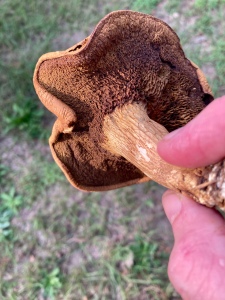
According to the Northeast Naturalist, The Ash-tree Bolete (also called Boletinus porosus and Gyrodon merulioides in some field guides) grows from Michigan to Eastern Canada and south to Texas and Florida.
This species is edible, but not recommended, partly because of the chance of confusion with several toxic boletes. That risk aside, the quality and flavor are said to be poor, at least in comparison to better mushrooms.
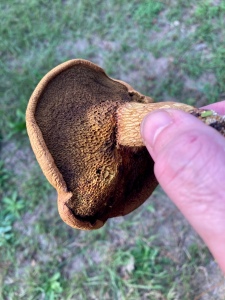
While the familiar mushrooms have radiating gills that produce the spores on the undersurface of the caps, Boletes are a family of mushrooms (Boletaceae) that have a spongy layer of pores or tubes on the underside to do the same job.
Boletes are soft, fleshy and stalked and often grow in the woods. Many of the 200 North American species are edible, but only a few are worth the effort of collecting, and several are poisonous, so use caution.
I’m definitely not a fungi or mushroom expert by any means. I maybe totally wrong about this mushroom. The mushroom series is a learning process for me.
If anyone has knowledge of this mushroom, feel free to leave a comment and add whatever type of helpful information which you may have. Thanks!
And as always, never eat any mushroom or plant unless you have definitive knowledge, information, and experience with it. Stay safe and get outdoors to explore our world.
References:
#143: Boletinellus merulioides, the Ash Tree Bolete
https://northeastnaturalist.blogspot.com/2013/07/ash-tree-bolete.html?m=1

Visit my eBay page to see the latest items available for sale here.
